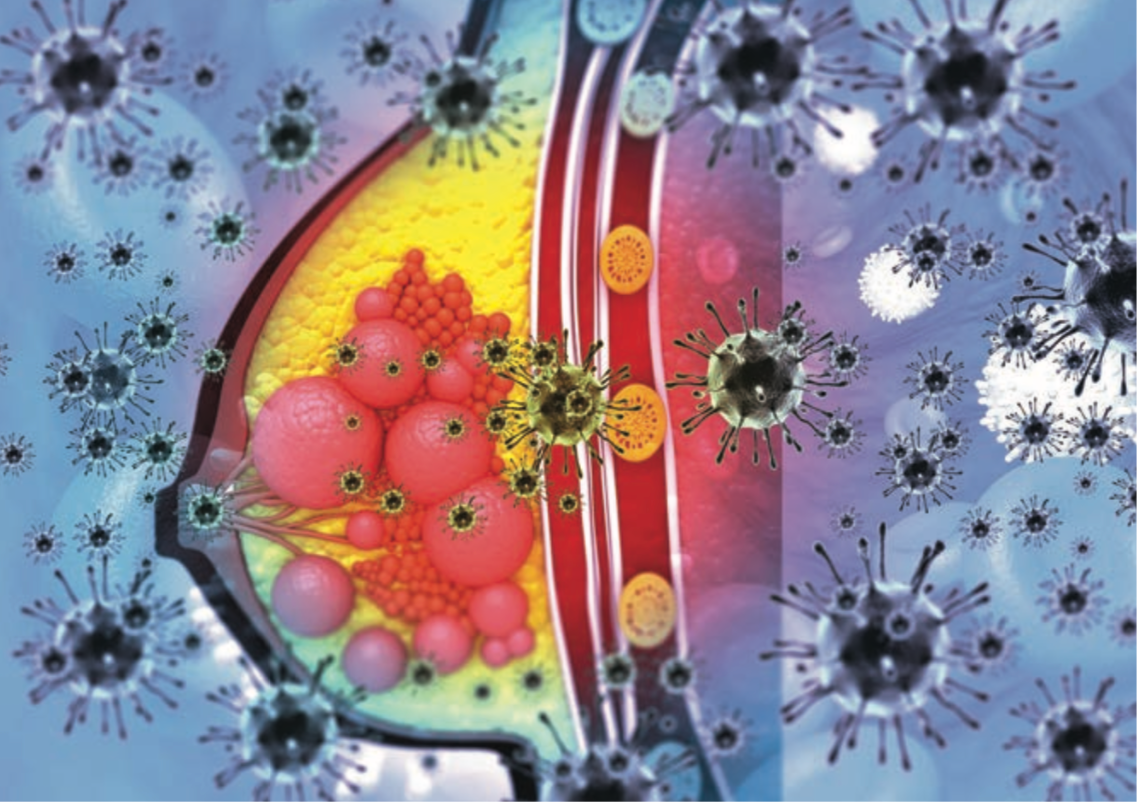Specific Biomarkers Confer Higher pCR/EFS in Triple-Negative Breast Cancer
Data from KEYNOTE-522 show improved efficacy with pembrolizumab/chemotherapy across subgroups of patients with TNBC.
Among the non–T-cell-inflamed 18-gene expression profile consensus signatures, proliferation and glycolysis were positively associated with pCR in both arms but did not correlate with EFS.

Improvements in pathologic complete response (pCR) and event-free survival (EFS) with or without pembrolizumab (Keytruda) were associated with biomarkers such as T-cell inflamed 18-gene expression profiles in patients with high-risk early triple-negative breast cancer (TNBC), according to exploratory analysis data from the phase 3 KEYNOTE-522 study (NCT03036488) presented at the 2024 San Antonio Breast Cancer Symposium (SABCS).
These results come as of the data cutoff on March 23, 2021. Tumor mutational burden (TMB) also correlated with improved EFS in the pembrolizumab plus chemotherapy arm (P ≤.001), but not in the placebo plus chemotherapy arm (P =.011 for pCR; P =.422 for EFS). There were few patients with high TMB in this patient population of those with TNBC.
Further, the pembrolizumab/chemotherapy regimen offered an efficacy advantage compared with chemotherapy alone, regardless of subgroups defined by several biomarkers like TMB, T-cell inflamed 18-gene expression profile, and more.
About the KEYNOTE-522 Exploratory Analysis
The phase 3, randomized, placebo-controlled KEYNOTE-522 study sought to evaluate the combination of neoadjuvant pembrolizumab with chemotherapy and adjuvant pembrolizumab in patients with newly diagnosed, previously untreated, high-risk, early-stage TNBC. Previously reported findings have shown that neoadjuvant pembrolizumab with chemotherapy followed by adjuvant pembrolizumab significantly improved pCR, EFS, and overall survival (OS) vs neoadjuvant placebo plus chemotherapy with adjuvant placebo in patients with high-risk, early TNBC.
In this exploratory biomarker analysis, the end points included evaluating the association of TMB, T-cell inflamed 18-gene expression profile, and a set of non T-cell inflamed 18-gene expression profile consensus signatures with pCR and EFS. Secondary end points included evaluating RNAseq-based molecular subtypes, BRCA/HRD status, HER2 gene expression/signature, and PTEN loss signature associations with pCR and EFS.
Patients with newly diagnosed, previously untreated, high-risk, early TNBC and evaluable pretreatment tumor samples were enrolled in the study. A total of 1172 patients were randomly assigned and treated, including 783 in the pembrolizumab plus chemotherapy arm and 389 in the placebo and chemotherapy arm. There were 946 patients who had WES data, with 641 who received pembrolizumab/chemotherapy and 305 given placebo/chemotherapy, and 904 had RNAseq data, consisting of 618 and 286 across the study arms.
TMB was assessed through whole-exome sequencing (WES), while T-cell–inflamed 18-gene expression profile and non–T-cell-inflamed 18-gene expression profile consensus signatures were evaluated using RNA sequencing. Analyses were conducted according to a prespecified statistical analysis plan.
The associations of TMB, T-cell–inflamed 18-gene expression profile, and non–T-cell-inflamed 18-gene expression profile consensus signatures, which included proliferation, stromal/EMT/TGFβ, RAS, angiogenesis, gMDSC, glycolysis, hypoxia, mMDSC, MYC, and WNT pathways, with pCR were evaluated through the use of logistic regression and area under the receiver operating characteristic curve analysis, with 95% confidence intervals (CIs).
To evaluate EFS, Cox proportional hazards regression was used. TMB and T-cell–inflamed 18-gene expression profile analyses did not involve multiplicity adjustments, and nominal P-values <.05 were considered significant. Moreover, non–T-cell-inflamed 18-gene expression profile consensus signatures were analyzed with an adjusted alpha level of 0.10 using the Hochberg step-up procedure.
Additional Findings
Among the non–T-cell-inflamed 18-gene expression profile consensus signatures, proliferation and glycolysis were positively associated with pCR in both arms but did not correlate with EFS.
For the secondary end points of the study, positive associations of PTEN loss signature and BRCA/HRD status with pCR were observed in both treatment arms. HER2 gene expression was linked with the T–cell-inflamed 18-gene expression profile (correlation coefficient = -0.32); however, it did not show significant associations with pCR or EFS in the pembrolizumab/chemotherapy arm after adjustment for the T-cell–inflamed 18-gene expression profile.
Subgroup analyses of secondary biomarkers using prespecified cutoffs consistently confirmed the benefit of the pembrolizumab and chemotherapy combination over the chemotherapy and placebo combination.
Reference
O’Shaughnessy J. Exploratory biomarker analysis of the phase 3 KEYNOTE-522 study of neoadjuvant pembrolizumab or placebo plus chemotherapy followed by adjuvant pembrolizumab or placebo for early-stage TNBC. Presented at the 2024 San Antonio Breast Cancer Symposium; December 10-13, 2024; San Antonio, TX. LB1-07.
Newsletter
Stay up to date on recent advances in the multidisciplinary approach to cancer.